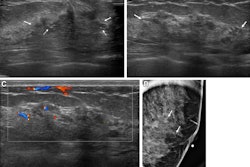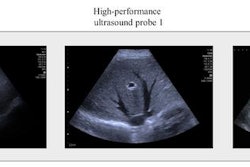A computer-aided diagnostic (CAD) system improves the diagnostic performance of breast ultrasound, according to findings published October 6 in Heliyon.
Researchers led by Pengjie Song, MD, from Gangkou Hospital in Hebei found that CAD-assisted ultrasound can help recognize benign lesions, especially in patients with a BI-RADS 4A designation, and avoid unnecessary invasive procedures.
“CAD systems can overcome … drawbacks and improve the diagnostic capability of breast ultrasound,” Song and colleagues wrote.
Ultrasound is the go-to modality for diagnostic breast imaging after suspicious mammography findings. This especially goes for high-risk women, such as those with dense breasts. However, conventional ultrasound isn’t without its faults. Previous reports have shown that the modality is susceptible to false-positive results, leading to unnecessary biopsy or surgery. Ultrasound is also an operator-dependent method.
AI meanwhile continues to push its way into the radiology field, with previous studies demonstrating the technology’s ability to improve cancer detection on imaging.
Song and co-authors sought to investigate the performance of breast ultrasound with a CAD system for detecting malignant breast cancer compared with conventional ultrasound. They also explored the performance of CAD-assisted ultrasound (S-Detect, Samsung Medison) on tumors 20 mm and smaller.
The researchers included 123 women with breast masses in their retrospective study, with data collected between 2021 and 2023. They used pathology results from biopsies and surgeries as the gold standard. Of the total study population, 27 women were pathologically diagnosed with malignant breast cancer.
The team found that CAD assistance led to greater overall performance in both average-sized and smaller tumors compared with conventional breast ultrasound.
| Ultrasound performance with, without CAD assistance |
||
|---|---|---|
| |
Conventional ultrasound |
CAD |
| Specificity |
62.5% |
92.71% |
| Accuracy |
69.92% |
93.5% |
| Area under the curve (AUC) |
0.794 |
0.945 |
| Lesions 20 mm or smaller |
||
| Specificity |
51.43% |
91.43% |
| Accuracy |
58.14% |
90.7% |
| AUC |
0.6946 |
0.8946 |
*All data achieved statistical significance.
The researchers also reported that the agreement between the CAD and pathology results was almost perfect (kappa = 0.82, p < 0.0001).
Finally, they reported 31 downgrades in BI-RADS 4A (low suspicion of malignancy) and 4B (moderate suspicion for malignancy) based on CAD, all of which were proven to be benign. To compare, the radiologists predicted malignancy in 62 cases using conventional ultrasound.
The study authors suggested that if CAD results are considered a decision-making factor, “at least” one-quarter of patients could avoid invasive procedures.
“Based on the current findings, we recommend that health practitioners be more confident about making decisions among patients in the lower categories using CAD results to prevent unnecessary invasive procedures,” they wrote. “CAD can also be used to train and provide support to inexperienced young readers.”
The full study can be found here.



















